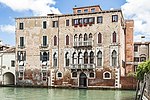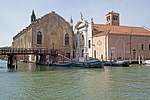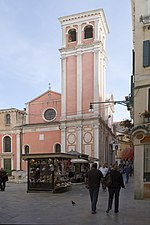I Gesuiti, Venice
18th-century Roman Catholic church buildings in ItalyBaroque architecture in VeniceRoman Catholic churches in Venice

The church of Santa Maria Assunta, known as I Gesuiti, is a religious building in Venice, northern Italy. It is located in the sestiere of Cannaregio, in Campo dei Gesuiti, not far from the Fondamenta Nuove.
Excerpt from the Wikipedia article I Gesuiti, Venice (License: CC BY-SA 3.0, Authors, Images).I Gesuiti, Venice
Campo dei Gesuiti, Venice Venezia-Murano-Burano
Geographical coordinates (GPS) Address External links Nearby Places Show on map
Geographical coordinates (GPS)
| Latitude | Longitude |
|---|---|
| N 45.443333333333 ° | E 12.339166666667 ° |
Address
Chiesa di Santa Maria Assunta
Campo dei Gesuiti
30170 Venice, Venezia-Murano-Burano
Veneto, Italy
Open on Google Maps











